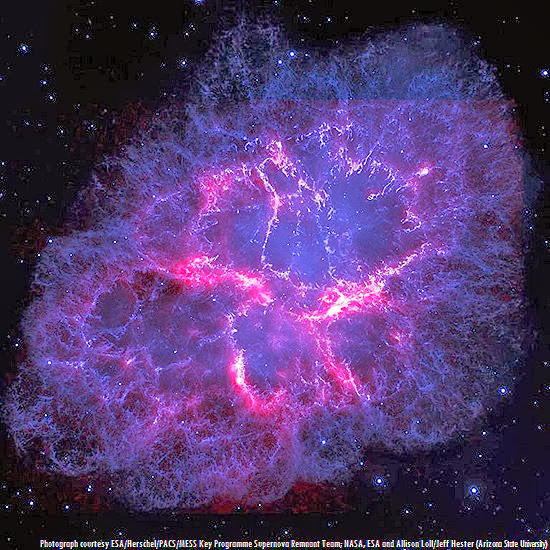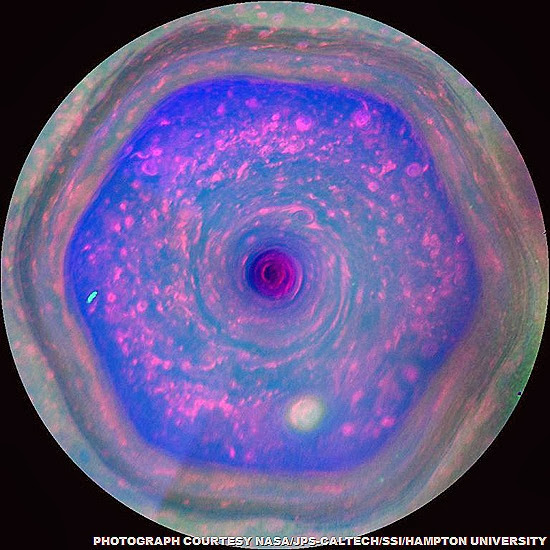
Best New Space Pictures: Titan's Lakes, Saturn Shakes, and a Nebula Bakes
By Dan Vergano, National Geographic News, 13 December 2013.
By Dan Vergano, National Geographic News, 13 December 2013.
Saturn and its giant moon, Titan, take centre stage in the week's top space pictures.
1. Season's Marks Left on Mars
Summer and winter leave their marks on Mars, too, as seen in a crater slope that is lined with markings that advance and retreat with the seasons. (See also: "Mission To Mars".)
Called "recurrent slope linea," the markings on the slope of the crater near Valles Marineris on Mars grow longer in warm months, and then retreat as the weather cools over the course of the Martian year. Scientists suspect that briny water or liquid carbon dioxide under the surface warms and colours the lines during warmer months on Mars.
Captured by NASA's Mars Reconnaissance Orbiter, the changes were seen in the spacecraft's regular over-flight of the crater near the Martian equator.
2. Crab Crackles
Can you see the crab? The famed Crab Nebula, first observed by Chinese astronomers in 1054, is the remnant of a stellar explosion, or supernova.
Astronomers this week reported the discovery of chemical traces of the gas argon amid the blasted-apart star debris of the nebula, the first detection of a noble gas in space.
That's not a surprise, since astronomers have known since the 1930s that most of the lighter elements in the cosmos are released from exploding stars, but the discovery makes a nice confirmation. The density of the gas seen in the nebula can also help explain the supernova's original star.
3. Titan's Lakes Mosaic
Saturn's moon Titan is a land of lakes, seen in this colorized mosaic of the frozen mini-world released by NASA's Cassini spacecraft team.
The largest sea on Titan, Kraken Mare, appears as the body in black and blue resting just below the moon's north pole, in the centre of the map. Most of the lakes appear to be liquid ethane and methane, basking in Titan's surface temperature of -290° Fahrenheit (-179° Celsius).
The second largest moon in the solar system, Titan is the only one with a thick atmosphere. Planetary scientists are still unravelling how Titan's weather works, looking for an explanation of why the lakes cluster on the northern half of the moon.
4. Asteroids Streak Past Dying Star
Asteroids dash past a dying star, the Helix nebula, seen in this image from NASA's Wide-field Infrared Survey Explorer (WISE) spacecraft.
Far from our solar system, a remnant white dwarf star at the heart of the nebula heats gas and dust sloughed away from the original star at the centre of the nebula. The heated gas and dust glows, creating the nebula's beautiful appearance.
Much closer, asteroids (and the occasional spacecraft) zip past the nebula, seen as streaks across the sky. NASA has repurposed the WISE spacecraft as an asteroid hunter, taking advantage of its wide-field imaging capabilities.
5. Saturn's Beguiling North Pole
Effectively a hurricane capping Saturn, the six-sided jet stream bounding the north pole of the planet is revealed by a Cassini spacecraft over-flight.
Taken over ten hours on December 10, the images show "the hexagon" rotating about the top of the ringed planet. Inside the hexagon, vortices swirl in the opposite direction. The largest, the white swirl on the bottom right, is some 2,200 miles (3,500 kilometres) wide.





No comments:
Post a Comment
Please adhere to proper blog etiquette when posting your comments. This blog owner will exercise his absolution discretion in allowing or rejecting any comments that are deemed seditious, defamatory, libelous, racist, vulgar, insulting, and other remarks that exhibit similar characteristics. If you insist on using anonymous comments, please write your name or other IDs at the end of your message.